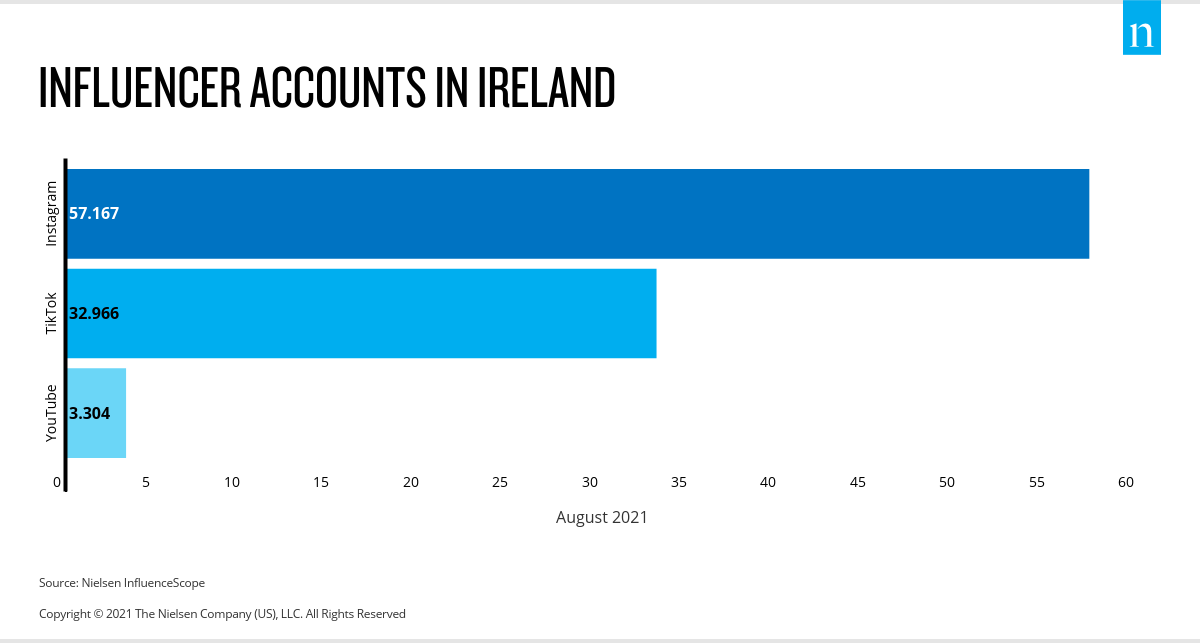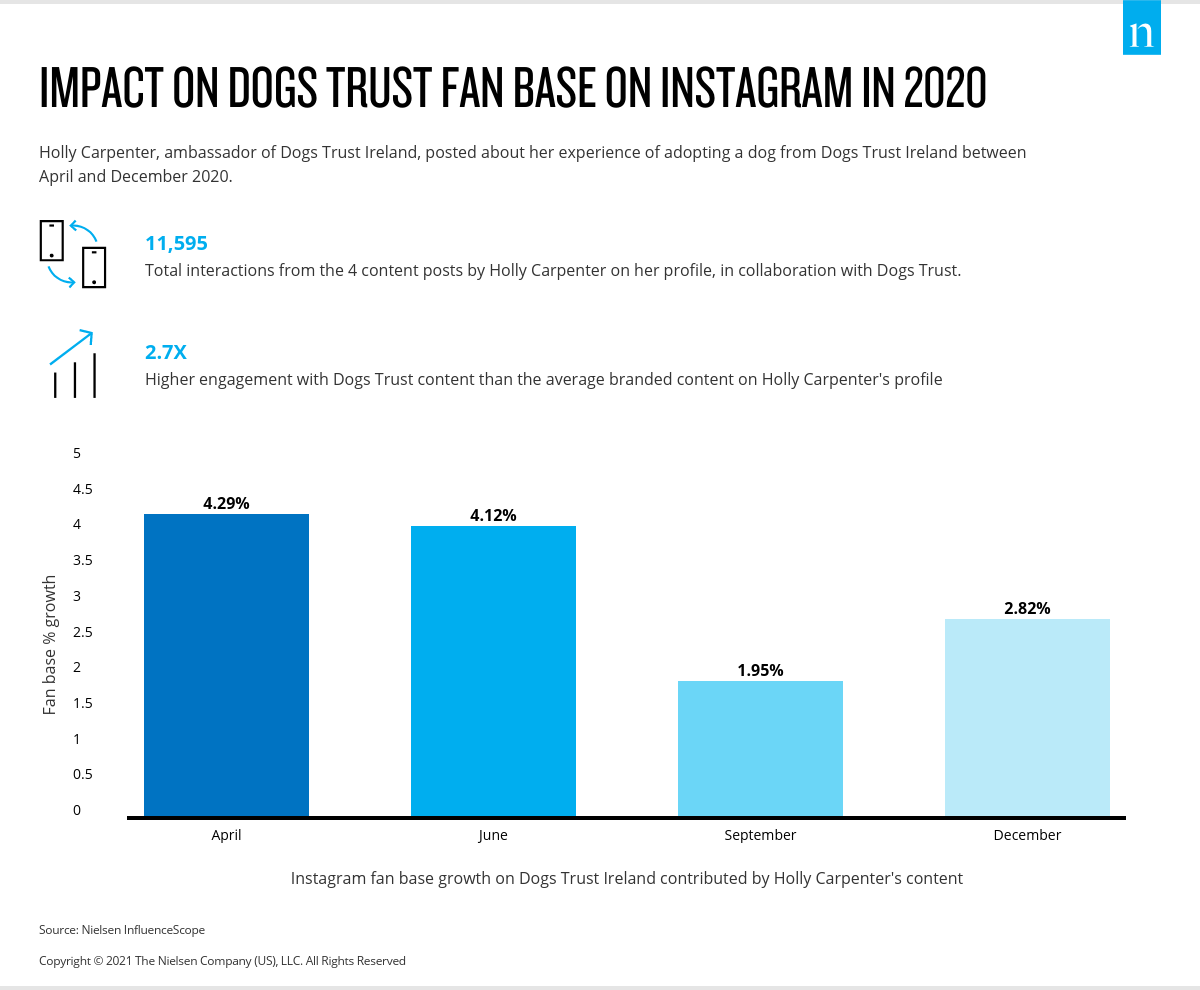With investment in influencer marketing on the increase, Cathy Heeley, International Media Analytics Lead, Nielsen and Lisa McNulty, Managing Director, Nielsen Media Ireland look at what it takes for brands to be successful with their influencer marketing strategies.
In an ever-changing world, brands must acclimate to new realities. However, the fundamental notion of brand building remains the same: brands need to create and build trust with consumers and be authentic in their messaging and in what they stand for.
In recent years, we have seen influencer marketing grow in popularity. As brands seek ways to establish deeper, more personalised connections with consumers, many are looking to social media influencers and the significant engagement that many of them boast across channels like YouTube, Instagram and TikTok.
WARC estimates that brands in Ireland will increase their social media ad spend by 24% this year, which is a stark reversal from the drop of 2.4% in 2020. The trends in Ireland are consistent with those across Europe. Research from IAB Europe found that creator marketing (influencer marketing) investment in Europe increased 14% to €1.3 billion, noting further growth expected for 2021. In addition to increased interest from advertisers, the pool of influences continues to rise. According to Nielsen InfluencerScope, there were 93,437 Irish influencer accounts with more than 1,000 followers on social media platforms in August 2021, a 58% increase from 2020.
Why are brands increasingly considering influencers as part of their marketing mix?
The realm of influencers is vast and not exclusive to big-name celebrities. While celebrity endorsements can be powerful, social media influencers are growing opportunities for brands, as they have a passion for their speciality subjects, create their own content and relate closely with the day-to-day lives of their followers. The people who follow them have actively chosen to do so, and for that reason, they can be powerful brand advocates and help to drive purchase intent. Using niche topics to resonate with their followers offers a targeting possibility to reach specific audiences for brands and when executed well, influencer marketing can deliver an impactful outcome.
So what drives a successful influencer campaign?
Like any marketing or advertising campaign, the success of an influencer campaign ultimately rests on its execution, and influencer marketing comes with its own unique set of challenges, most notably around transparency and authenticity. According to research conducted by the Advertising Standards Authority for Ireland (ASAI) in October 2020, over half (51%) of Irish consumers are concerned by a lack of transparency, and 59% consider influencers who do not seem authentic to be “annoying.” Across the influencer campaigns measured by Nielsen Brand Effect in Europe, one-third of those exposed stated that the content was “irritating,” suggesting that brands need to improve the strategies they employ in their influencer marketing efforts.
Good content is and always will be the foundation of any effective campaign, and influencer marketing is no different. Poor content will lead to incongruity in messaging meaning that, at best, consumers just won’t remember and, at worst, will result in consumers resenting the commercialisation of their favourite influencer’s content.
Over the past three years, Nielsen has been running Influencer Brand Effect measurement across influencer campaigns in Europe to help advertisers and agencies understand their impact on brand image and on people’s propensity to purchase their brand. The key metrics measured are brand awareness, favourability and consideration. Our research has found that the following best practice guidelines hold true: Content must be relatable and authentic.
Relatable content helps drive purchase intent. Of the influencer campaigns we’ve measured, just over half of those surveyed felt the content they were exposed to was relevant to them. Our analysis indicated that 65% of people remembered the content for the campaigns that drove high brand favourability, and almost 60% of people exposed to influencer marketing said they were likely to want to try or buy the product.
Regardless of category, brands need to navigate the growing pool of influencers to partner with to ensure the authenticity of your brand and message. Once you’ve identified the right influencer for your brand –by analysing their posts, follower comments and the products and services they enjoy —work with them to create authentic content. Even when the ultimate goal is to sell a product or service, marketers are increasingly seeking ways to be perceived as authentic and real. This is where influencers can assuredly help. Consumers are more likely to align themselves with brands that share their beliefs and values. If followers trust an influencer and their recommendations, they’re more likely to follow the brand and stay loyal.
In 2020, for example, influencer Holly Carpenter became an ambassador of Dogs Trust Ireland. As Holly suffers from mental health issues, she was keen to promote her belief that“man’s best friend” could help people cope with and possibly overcome similar issues. As ambassador, she created a campaign for her vision, which was well received by her followers. According to Nielsen InfluenceScope, Dogs Trust Ireland’s Instagram account gained 30% new followers.
We believe the momentum behind influencer marketing will continue, particularly as the pandemic has inspired higher traffic on social media platforms. Social media and influencer marketing have become useful marketing options for brands looking to expand their online presence. To be successful, influencer campaigns need to be carefully planned, executed and measured to ensure they deliver on key objectives. When used well as part of the marketing mix, they can be successful in achieving key objectives, help build positive brand associations and ultimately drive purchase intent.
METHODOLOGY
The insights in this article were derived from Nielsen InfluenceScope and Influencer Brand Effect.
InfluenceScope is Nielsen’s data-driven solution to support marketers throughout the entire Influencer Marketing Lifecycle. We assess the social media users with over 1,000 followers or subscribers exercising influence, on digital platforms, over digital users and audiences. We select the personalities to suit the specific objectives within a desired time frame, pre-evaluate the mix of contents, platforms, personalities and measure the media value and ROI.
Influencer Brand Effect measures the extent to which an influencer marketing campaign has driven uplift in brand KPIs and perceptual changes among the target audience, utilising a test and control approach. Our solution can split out results by platforms and specific influencers post campaign (sample permitting), identifying the factors which were successful at driving brand KPIs and identifying effective creative elements, providing crucial insights and recommendations for future campaigns.























